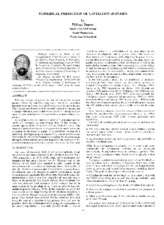| dc.contributor.other | International Pump Users Symposium (18th : 2001) | |
| dc.creator | Dupont, Philippe | |
| dc.date.accessioned | 2017-10-05T16:37:27Z | |
| dc.date.available | 2017-10-05T16:37:27Z | |
| dc.date.issued | 2001 | |
| dc.identifier.uri | https://hdl.handle.net/1969.1/164069 | |
| dc.description | Lecture | en |
| dc.description | pg. 59 | en |
| dc.description.abstract | With the increase in power per unit of volume for modern pumps, driven by manufacturing costs reduction, cavitation becomes more and more the main limiting factor in pump design. The classical one-dimensional design rules applied for decades are no longer sufficient, and for this reason, there is a strong need for more accurate numerical tools to predict the cavitation behavior of pumps. An original cavitation prediction method is presented and its results are compared to experimental data for five pumps of specific speeds from 15 to 125 (775 to 6500 US units). The numerical method introduced in this paper for the prediction for the cavitation development in pumps is a simplified version of a previously developed program successfully used in similar cases. Motivation for this simplification was to allow the program usage during the design process of suction impellers. The accuracy of this simplified method as well as its usage as a design tool is discussed. | en |
| dc.format.medium | Electronic | en |
| dc.format.mimetype | application/pdf | |
| dc.language.iso | en | |
| dc.publisher | Texas A&M University. Turbomachinery Laboratories | |
| dc.relation.ispartof | Proceedings of the 18th International Pump Users Symposium | en |
| dc.subject.lcsh | Pumping machinery | en |
| dc.title | Numerical Prediction Of Cavitation In Pumps | en |
| dc.type.genre | Presentation | en |
| dc.type.material | Text | en |
| dc.identifier.doi | https://doi.org/10.21423/R1ZM39 | |


